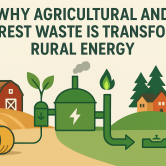Energy has always been a driving force for human development. Today, the global energy sector must balance growing demand with the urgent need to tackle climate change. Biomass energy stands out as a renewable source that delivers both environmental and economic benefits.
What is Biomass?
Biomass includes organic materials such as agricultural residues, forestry by-products, animal manure, aquatic plants, and organic industrial waste. These resources can be converted into heat, electricity, or biofuels. In rural areas, biomass ensures local energy security, supports agriculture and forestry, and improves waste management.
Rural Biomass Resources
Agricultural Residues: Straw, corn stalks, pruning waste.
Animal Waste: Manure and slurry from livestock farms.
Forestry Residues: Wood chips, bark, and thinning materials.
Agro-industrial By-products: Fruit pulp, dairy waste, sugar mill residues.
Aquatic Biomass: Algae and seaweed.
Energy Conversion Methods
Biomass can be turned into energy using:
Direct Combustion for heat and power.
Gasification to produce syngas.
Anaerobic Digestion to generate biogas.
Biofuel Production (biodiesel, bioethanol).
Torrefaction and Pelletization for high-density fuel.
Sustainability and EU Standards
The Renewable Energy Directive II (RED II) sets strict sustainability requirements for biomass production, ensuring biodiversity protection, greenhouse gas reduction, and positive socio-economic impacts.
Relevance to the SUSRUD Project
SUSRUD aims to harness rural biomass potential to:
Achieve energy independence
Improve waste management
Create local jobs
Increase resource efficiency
Conclusion
When sustainably managed, biomass energy can boost rural development, create green jobs, and support climate goals. The SUSRUD project positions biomass as a cornerstone of a low-carbon, sustainable energy future.




